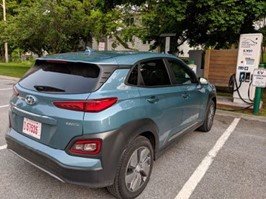EV Future — Enough Chargers?
The number of Electric Vehicles (EV’s) on the road is increasing quickly, spurred on by government subsidies, concern for the climate, and Hanover’s own goal of 100% renewable transportation by 2050. Over 300,000 EV’s were sold in the US in 2019. Most car manufacturers are phasing out gas engines. In Hanover alone, there are 96 fully Electric cars registered, up 57% from 2020.
But these cars need to be charged. Most people with EV’s do most of their charging at home, but for people who live in apartments, and for trips longer than the range of the car, there need to be public chargers. That has become the focus of the efforts to move towards electric transportation. The federal bi-partisan infrastructure bill and the VW settlement funds will increase the number of chargers statewide and nationally. Locally, Hanover, in collaboration with Lebanon and Hartford, is developing a plan for public chargers. So, charging will soon be a less of a concern for hesitant EV buyers.
These chargers need to be in convenient places and the right kind and to be useful. There are three basic types of chargers. All EV’s come with a cord for a regular 110 volt outlet. This is called level 1 charging and most people already have the ability to charge with level 1 at home. This is slow, however, about 5 miles of charge per hour of charging, so it works for charging overnight and only if you drive less than 40 miles a day. Employers can supply level 1 charging for low cost, and an 8 hour workday will give many employees enough charge for their commute home.
But most EV owners install a level 2, or 220 volt, charger so they can go on longer and more frequent trips. These chargers are useful in public places, as long as the car will be there for an hour or more. They will give you 15-25 miles per hour of charging, depending on the car, the amperage of the charger, and the temperature. (Cold temperatures reduce the miles an EV will go on a charge.) So public level 2 chargers can be used to draw customers to shopping areas, restaurants, hotels, ski areas, or anywhere that it is convenient to park for a few hours. My son charges his Nissan Leaf at public level 2 chargers that are a short walk from his home in Golden, Colorado.
Some level 2 chargers are free to use. Others, you pay with a credit card or a card from a network like ChargePoint®. Businesses that install level 2 chargers might want to give the electricity away in order to attract customers, because the cost of the electricity is minor compared to the cost of a networked, or “smart” charger that charges for the electricity used.
Four hours of charging might use $2 to $4 of electricity, and a networked charger costs $7,000 to $10,000, (or a monthly fee) so it is a long time before the cost of the charger is recovered. On the other hand, a basic charger costs about $500 plus installation.
For long distance travel, however, an EV driver needs a DC fast charger, sometimes called level 3. These can charge a car to 80% of its capacity (the last 20% charges much more slowly) in 20-60 minutes, long enough to stretch your legs, get a cup of coffee, or walk the dog. These are very expensive to install, upwards of $50,000, depending on whether there is three-phase power available nearby. So, it is DC fast chargers that are targeted by federal and state funds. The federal infrastructure bill envisions a network of chargers across the country on all major roads, enabling EV drivers to go anywhere without “range anxiety”.
DC fast chargers are already common along Interstate highways. Tesla has a network of over 1200 stations, although these are dedicated to Teslas only. Tesla has promised to make them available to other users, but it has not happened yet. Plug Share and many other EV web sites show a map of all EV charger locations. Currently, there are about 132 public EV charging stations in NH and 25 of these are DC fast chargers. You may have noticed the Tesla chargers beside Price Chopper in West Lebanon, and the newly installed Electrify America fast chargers outside Walmart.
Public Level 2 charging is also available locally. Hanover has four level 2 chargers in the parking garage, and plans for more in the future. The hospital (DHMC) has chargers in the parking garage. Dartmouth College has charging stations at two surface lots and in the new Thayer Engineering & Computer Science Center underground parking garage and has ambitious plans to provide charging in all its parking lots.
So, charging away from home is available, but takes a bit of planning. Many people have driven on long trips in their EV, but route finding can be more complicated than in a gas car. Planning is aided by apps that map out a route with chargers. ABRP has a trip planner that describes where to stop for charging and for how long. It takes into account what EV you have and identifies chargers that are not working. Most Tesla’s have that capability built into the navigation system.
There is a risk that with increasing numbers of EV’s on the road, chargers may be in use when you get there. The chargers at ski areas - Killington, Sugarbush, and Loon for example - are often all in use after 10:00 in the morning, especially on weekends. And sometimes a charger you are counting on is out of service. The PlugShare map includes user reviews that will identify plugs that are broken or frequently in use.
Clearly, if EV growth meets predictions, (most manufacturers will only be selling electric vehicles within a few decades) and if Hanover is to meet its goal of 100% renewable transportation by 2050, we need more public chargers. And they are on their way. Three million dollars of New Hampshire’s share of the VW settlement money is allocated to chargers along the major highways. The request for proposals that the State sent out in the fall netted 30 applications, so this will soon add to existing chargers. Plus, the State is due to receive $17 million from the infrastructure bill for fast chargers. Employers, businesses, and recreation areas are installing more and more chargers to attract clients and employees. We can look forward to a future when stopping for gas is a thing of the past, a time when we can leave home with a full battery and fill up on the road without going out of our way and without adding to global greenhouse gasses.

